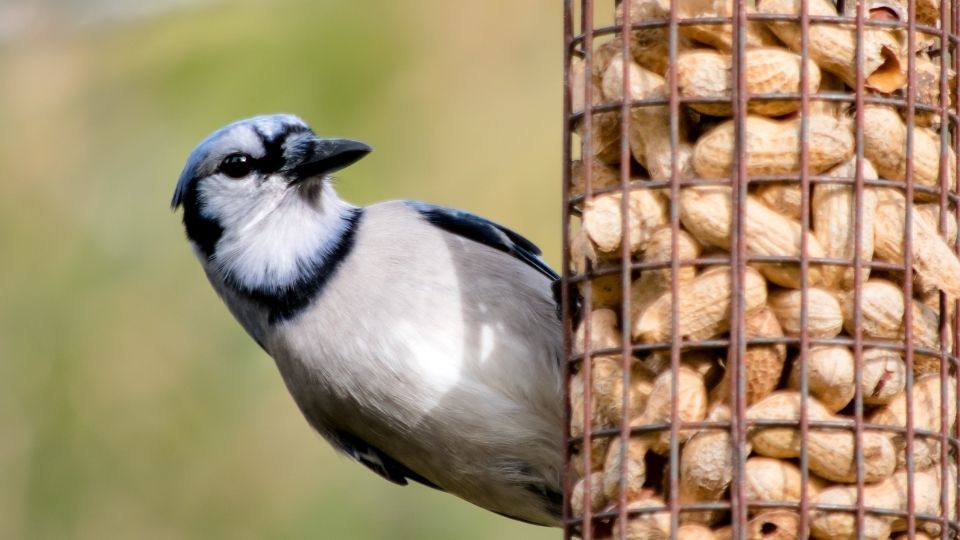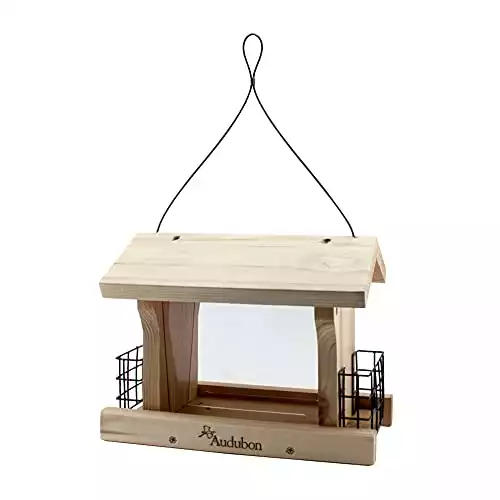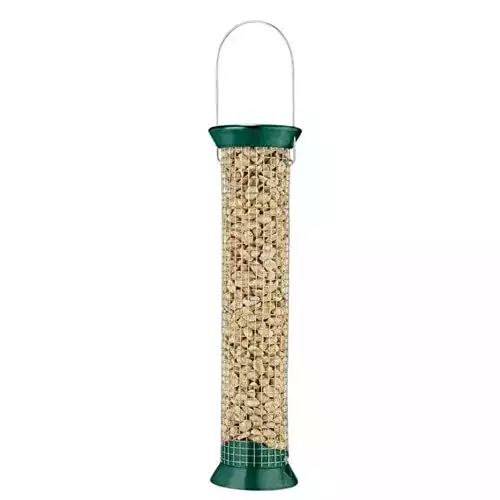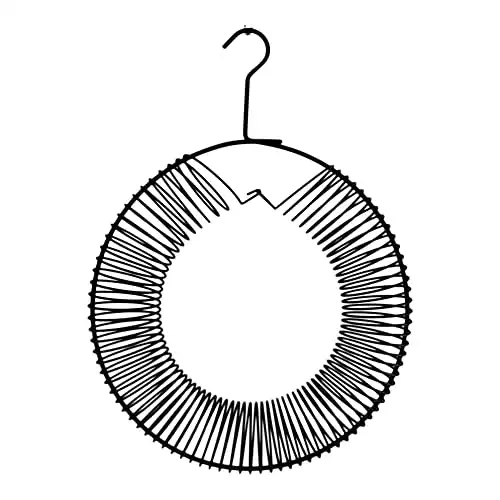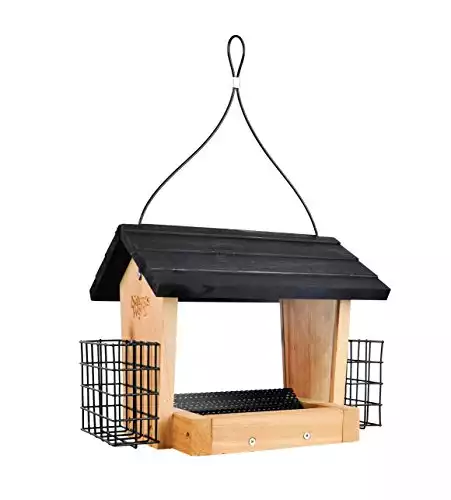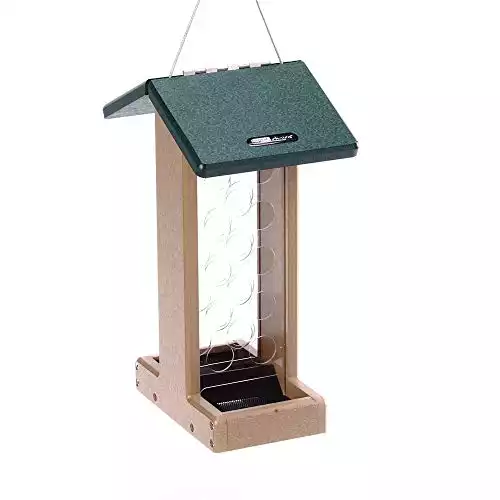Blue Jays aren’t delicate and petite birds. Many standard feeders found at department stores are great for birds like sparrows, titmice, or finches, but they are often too small for blue jays.
When choosing feeders for blue jays, it’s essential to consider their feeding preferences and behaviors. Blue jays are larger birds with strong beaks, so the ideal feeders should accommodate their size and feeding style.
Check out our list of the 5 best blue jay feeders to buy as well as our tips on how to choose a blue jay feeder that will be effective in attracting these songbirds to your backyard.
Top 3 Comparison Table
|
|
|
|
|
Pros:
|
Pros:
|
Pros:
|
- Tray design reduces seed waste
- Opportunity to attract suet-loving birds as well as blue jays
- Rustic and attractive look
- Four feeding ports
- The twist-and-release removable base and spring-loaded top facilitate easy filling and cleaning
- Inclusion of a seed tray
- Metal construction
- Easy to fill and clean
- Lightweight and easy to hang
- Can feed multiple birds at the same time
Our Top 5 Picks
1. Woodlink NARANCH3 Audubon Cedar Ranch Wild Bird Feeder
- Ideal for ground-feeding birds
- Resistant to weather and decay
- Substantial seed capacity
- Open platform
- Durable perches
- Suitable for various birdseed
The Woodlink Audubon Cedar Ranch feeder is loved by many songbird enthusiasts out there.
The feeder is made from cedar wood, making it suitable for outdoor use. The 12-inch size offers a generous seed capacity, allowing for less frequent refilling and accommodating the appetites of many birds.
The feeder is equipped with multiple feeding ports, allowing several birds to feed at the same time.
The addition of two cages for holding suet cakes is a useful feature, as suet cakes are a high-energy food source that is particularly popular with insect-eating birds like woodpeckers, nuthatches, and chickadees. By offering suet cakes alongside birdseed, you can attract a more diverse range of bird species to your backyard, not just blue jays.
Pros
- The tray design helps reduce seed waste and keeps the feeding area cleaner
- Opportunity to attract suet-loving birds as well as blue jays
- The natural cedar wood construction lends a rustic and attractive look to the feeder
Cons
- The open tray design of the feeder makes it easier for squirrels to access the birdseed and suet cakes.
2. Droll Yankees New Generation Peanut Feeder
- Weather resistant
- Adjustable perches
- 4 feeding ports
- Large capacity
- Very easy to fill and clean
This peanut feeder with 180-degree, 2-position rings allow the feeder to dispense peanuts from multiple angles. Birds can access the peanuts from either side of the feeder, which accommodates different feeding positions and preferences.
With 4 feeding ports and a capacity of up to 3 pounds of birdseed, the feeder can hold a significant amount of food, reducing the need for frequent refilling
The twist-and-release removable base allows users to quickly and easily disassemble the feeder for cleaning. With a simple twist, the base can be removed, providing access to the interior for thorough cleaning.
Also, the spring-loaded top makes refilling the feeder a breeze.
Pros
- With four feeding ports, the feeder allows multiple birds to feed simultaneously, reducing competition
- The twist-and-release removable base and spring-loaded top facilitate easy filling and cleaning
- The inclusion of a seed tray provides additional feeding space for birds and catches fallen seeds
Cons
- Limited feeder’s appeal to attract a broader variety of bird species
3. Songbird Essentials Whole Peanut Wreath Feeder
- Sturdy construction
- Hanging loop
- Easy to fill
- Compatible with suet or seed mixes as well
The Songbird Essentials peanut wreath feeder is a popular bird feeder designed to attract blue jays as well as other songbirds.
The feeder is made of durable metal, which can withstand the elements and the pecking of larger birds like blue jays. The circular wreath design allows multiple birds to feed from different angles simultaneously.
It holds whole peanuts, which are loved by blue jays and other nut-loving birds.
It comes with a hanging hook, making it easy to suspend from a tree branch or a feeding station.
Besides blue jays, you can expect to attract other bird species like woodpeckers, chickadees, nuthatches, and more.
Pros
- Metal construction
- Lightweight and easy to hang
- Easy to fill and clean
Cons
- Squirrels are quick to eat all the peanuts; frequent refills needed
4. Nature’s Way Cedar 3 Quart Hopper Bird Feeder with Suet
- Suet cage
- Multiple feeding ports
- Roof overhang
- Attractive design
- Easy filling
- Versatile hanging options
The feeder is made from durable cedar wood. Cedar also provides a natural and attractive appearance that blends well with outdoor surroundings.
In addition to the large seed compartment, the feeder is equipped with a suet cage or holder. This feature allows you to offer suet cakes and attract a broader range of bird species.
The feeder’s design includes a roof overhang that helps protect the birdseed from rain and snow, keeping it dry and fresh for the birds.
The hopper-style design makes it easy to fill, reducing the need for frequent refilling.
Pros
- Attractive design
- The feeder’s combination of the main seed compartment and suet cage attracts birds that prefer seeds and nuts and those that enjoy suet cakes
- Accommodates several birds feeding simultaneously
Cons
- Suet can attract insects, especially during warmer months
5. Birds Choice Whole Peanut Blue Jay Feeder
- Good construction
- Holds whole peanuts
- Easy to clean
- Roof keeps peanuts dry
By offering whole peanuts, this feeder is intended to draw blue jays to your backyard or garden.
With acrylic plexy panels with large holes, the blue jays can easily access the peanuts and use their strong beaks to crack them open and retrieve the nutritious nuts inside. This design allows birds to feed comfortably and efficiently, encouraging more frequent visits to the feeder.
Acrylic plexy panels are also known for their durability and resistance to weather and UV rays. This ensures that the feeder can withstand outdoor elements, keeping the peanuts dry and protected from rain and snow.
The feeder comes with a green roof, which adds a decorative touch to the feeder while also providing some protection for the peanuts from rain and snow.
Pros
- Specifically intended to attract blue jays
- Sturdy and weather resistant
- Easy peanut access
Cons
- Frequent refilling of whole peanuts is necessary to keep the feeder active and attract blue jays consistently
What Is A Blue Jay’s Favorite Food?
They like classic songbird mixes containing cracked corn, sunflower seeds, and thistle, but these are not their favorite food. Blue Jay’s favorite food are peanuts.
You can opt for shelled peanuts (to save on money) or unshelled peanuts. The trick to using peanuts to attract blue jays is the best way to attract these songbirds to your yard, but it comes with one tiny little bushy-tailed problem: squirrels.
Before you bust out the peanuts, you first need to find a feeder made for peanuts that’s also squirrel-proof.
What Types of Feeders Are Best for Blue Jays?
Peanut Feeders
Dedicated peanut feeders are harder to come by than typical tube feeders intended for smaller birds.
However, places like Amazon have plenty of options that are super affordable and easy to install. A few different types of high-quality peanut feeders work, all with varying levels of keeping squirrels away.
In the video below, we rounded up 10 of the most fascinating facts about Blue Jays!
Peanut Wreath Feeder
A peanut wreath feeder is more than just a decorative feeder. While it looks pretty, it’s also the perfect way to attract blue jays (and also woodpeckers and other larger backyard birds).
Plus, the unique shape makes it almost impossible for pesky squirrels to get their hands on nuts from this uniquely-shaped feeder.
The downside to a peanut wreath feeder is that it only works with shelled peanuts, which can get a little pricy.
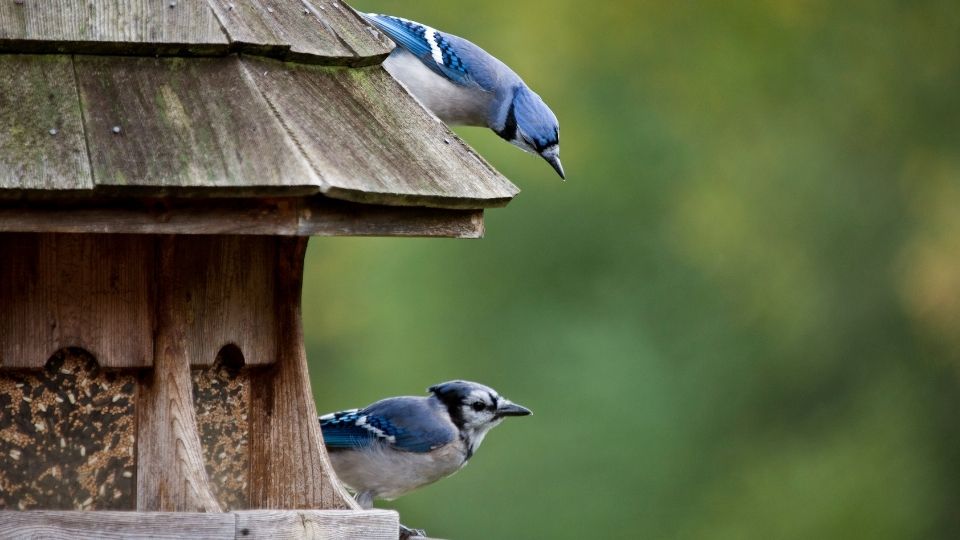
Tray Feeder
A tray feeder is a simple and affordable way to feed blue jay‘s unshelled peanuts. It’s positioned up off of the ground to protect them from ground predators, and it’s super easy to fill. Plus, you can fill it with just about anything.
If you run out of peanuts, throwing in some extra songbird birdseed, acorns, or sunflower seeds keeps them fed while you restock on peanuts.
The downside to tray feeders is that the open design welcomes all types of backyard critters, including those gluttonous squirrels.
Metal Peanut Tube Feeder
A metal peanut tube feeder looks very similar to classic songbird tube feeders with a few significant differences.
First, the metal mesh is much larger and is designed specifically for peanuts. It also has a bigger frame and larger perches made for large birds such as blue jays and woodpeckers.
The metal peanut tube feeder is built tough to last throughout harsh winters and is super easy for Blue Jays to access. While it isn’t as squirrel-proof as a peanut wreath feeder, it isn’t relatively as easy to access as a tray feeder.
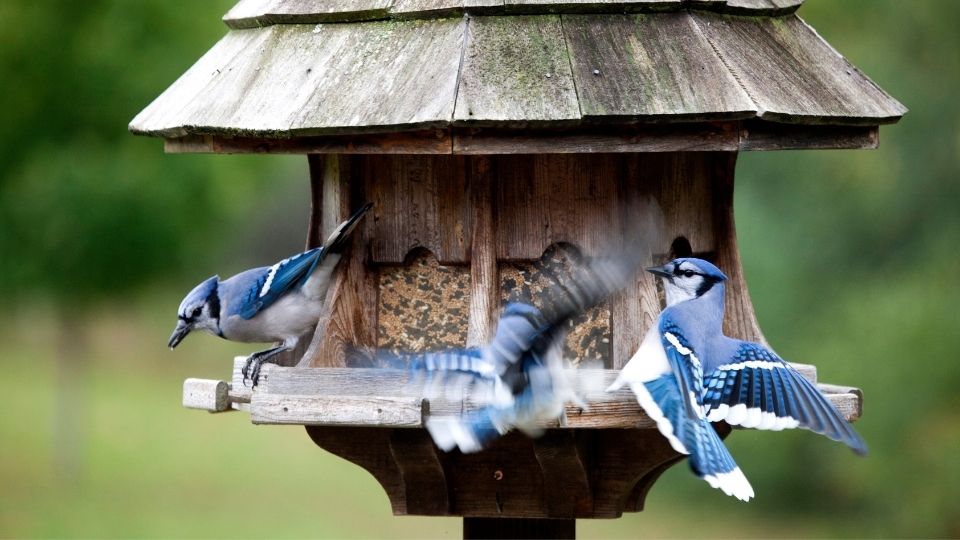
Tips to Attract Blue Jays to Your Backyard
- Blue jays also enjoy sunflower seeds, so having a bird feeder stocked with sunflower seeds will attract them to your yard.
- Hang feeders at different heights to cater to blue jays’ preference for feeding at various levels. Some may prefer ground-feeding, while others may favor elevated feeders.
- If you want to buy a feeder that works for all wild birds, both big and small, the size of the perch is key. Always select feeding stations with large perches that make it easier for larger birds to feed.
- A good birdbath is another great food-free way to attract blue jays. When selecting a bird bath, remember that these birds (especially the Northern blue jay) are quite large. Pick a bird bath with a shallow edge and a deep bottom that’s big enough for blue jays but not too big for smaller birds.
- You can even build your own blue jay house! Since blue jays prefer open spaces rather than an enclosed house, making your own is fairly simple.
- Blue jays are wary birds, and they feel more secure in areas with cover and shelter. Planting dense bushes, shrubs, or trees around your yard can offer hiding places and nesting opportunities.
With the right food (hint: it’s peanuts!), a good feeding station, and a few squirrel-proof tactics, you can transform your backyard space into a blue jay paradise.
What to read next:

